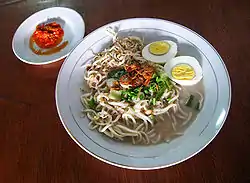Mung bean sprout
Mung bean sprouts are a culinary vegetable grown by sprouting mung beans. They can be grown by placing and watering the sprouted beans in the shade until the roots grow long. Mung bean sprouts are extensively cultivated and consumed in East Asia.
| Mung Bean Sprout | |||||||||||||
|---|---|---|---|---|---|---|---|---|---|---|---|---|---|
 | |||||||||||||
| Chinese name (Mandarin, Taiwanese) | |||||||||||||
| Traditional Chinese | 豆芽 | ||||||||||||
| Simplified Chinese | 豆芽 | ||||||||||||
| Literal meaning | Bean sprout | ||||||||||||
| |||||||||||||
| Chinese name (Mandarin) | |||||||||||||
| Traditional Chinese | 綠豆芽 | ||||||||||||
| Simplified Chinese | 绿豆芽 | ||||||||||||
| Literal meaning | Green bean sprout | ||||||||||||
| |||||||||||||
| Chinese name (Cantonese) | |||||||||||||
| Chinese | 芽菜 | ||||||||||||
| |||||||||||||
| Chinese name (Taiwanese) | |||||||||||||
| Chinese | 豆菜 | ||||||||||||
| |||||||||||||
| Vietnamese name | |||||||||||||
| Vietnamese | giá đỗ, giá đỗ xanh | ||||||||||||
| Thai name | |||||||||||||
| Thai | ถั่วงอก | ||||||||||||
| RTGS | thua ngok | ||||||||||||
| Korean name | |||||||||||||
| Hangul | 숙주나물 | ||||||||||||
| Literal meaning | Sukju namul | ||||||||||||
| |||||||||||||
| Japanese name | |||||||||||||
| Kanji | 萌やし | ||||||||||||
| Kana | もやし | ||||||||||||
| |||||||||||||
| Malay name | |||||||||||||
| Malay | tauge, tauge halus | ||||||||||||
| Indonesian name | |||||||||||||
| Indonesian | kecambah, kecambah kacang hijau, taoge | ||||||||||||
| Filipino name | |||||||||||||
| Tagalog | toge | ||||||||||||
| Khmer name | |||||||||||||
| Khmer | សណ្ដែកបណ្ដុះ sândêkbândŏh | ||||||||||||
Cultivation
A variety of techniques are used for sprouting mung beans. A common technique for home growers is sprouting the beans in a jar, with a fine mesh or muslin cloth tied over the top with a rubber band or string. Fresh water is then poured into the jar three to four times a day; the jars are then upturned and left to drain. The precise growing technique to use depends on the amount that one wants to collect. The main principles are: selecting good seed (new and uniform), ensuring that light reaches the seeds, and also ensuring they receive enough humidity while avoiding waterlogging.[1]
 Sprouting mung beans in a jar
Sprouting mung beans in a jar
Culinary use
.jpg.webp)
Mung bean sprouts can be microwaved or stir fried. They may also be used as an ingredient, e.g., for spring rolls.
China
In Chinese cuisine, common dishes that may use mung bean sprouts, known as dòuyá (豆芽), are fried rice, spring rolls, egg drop soup, and hot and sour soup.[2]
In Cantonese cuisine, bean sprouts are used dishes such as egg fu yung and beef chow fun.[3]
.jpg.webp) Stir-fried turnip cake and mung bean sprouts
Stir-fried turnip cake and mung bean sprouts
India
In Indian cuisine, especially in Maharashtrian cuisine, Usal is a spicy dish that balances the heat of curry with either moong beans or sprouts.
 Spicy curry with sev and mung beans
Spicy curry with sev and mung beans
Japan
In Japanese cuisine, moyashi (もやし, "bean sprout") in a strict sense refers to the mung bean sprout. They are a common ingredient in many Japanese dishes such as stir-fries and soups.
 Ramen with mung bean sprout topping
Ramen with mung bean sprout topping
Korea
In Korean cuisine, sukjunamul (숙주나물) refers to both the mung bean sprouts themselves and the namul (seasoned vegetable dish) made from mung bean sprouts. Mung bean sprouts are not as common an ingredient as soybean sprouts in Korean cuisine, but they are used in bibimbap, in the fillings of dumplings and in sundae (Korean sausage).
The name sukjunamul is a compound of Sukju and namul, of which the former derived from the name of Sin Sukju (1417–1475), one of the prominent Joseon scholars. Sin Sukju betrayed his colleagues and favoured the King's uncle as a claimant to the throne. People regarded Sin Sukju's move as unethical and immoral, and so gave his name to mung bean sprouts, which tend to go bad and spoil very easily.[4]
 Sukjunamul (seasoned mung bean sprouts)
Sukjunamul (seasoned mung bean sprouts)_2.jpg.webp)
Nepal
In Nepalese cuisine, kwati, a soup of nine types of sprouted beans, is especially prepared in a festival of Janai Purnima which normally falls in the month of August. Kwati is prepared by frying and mixing onion, garlic, ginger, potatoes, spices and bean sprouts, including mung bean sprouts. A lot of variation exists from house to house but is basically about making the kwati. It is considered to be a nutritious food in Nepal. Kwati is normally eaten with rice. Sometimes meat (esp. fried goat) is also added to spice up the kwati.
Thailand
In Thai cuisine, mung bean sprouts are usually eaten in soups and stir-fried dishes. In pad thai they are often added to the pan for one quick stir before serving and in soups such as nam ngiao they are sprinkled on top of the dish.[5]
Indonesia
Mung bean sprouts are used widely in Indonesian Cuisine. Mung bean sprouts usually accompany soup dishes such as rawon, mie celor, or soto; mixed in Indonesian vegetable salads such as pecel, karedok, or gado-gado; and stir fried like in tauge goreng
 Tauge goreng (stir-fried mung bean sprout)
Tauge goreng (stir-fried mung bean sprout) Karedok (raw vegetables salad)
Karedok (raw vegetables salad)
Vietnam
 Phở with mung bean sprout topping
Phở with mung bean sprout topping
See also
References
- Takeguma, Massahiro. "Growing Moyashi". Retrieved 9 April 2013.
- Bean Sprouts Recipes
- "Beef Chow Fun". thewoksoflife.com. December 9, 2019. Retrieved January 29, 2021.
- 송, 백헌 (9 June 2016). "숙주나물, 성삼문과 멀어진 신숙주의 변절" [Sukjunamul, the betrayal of Sin Sukju who became estranged from Seong Sammun]. Joongdoilbo (in Korean). Retrieved 3 January 2017.
- Bean Sprouts - ThaiTable.com

